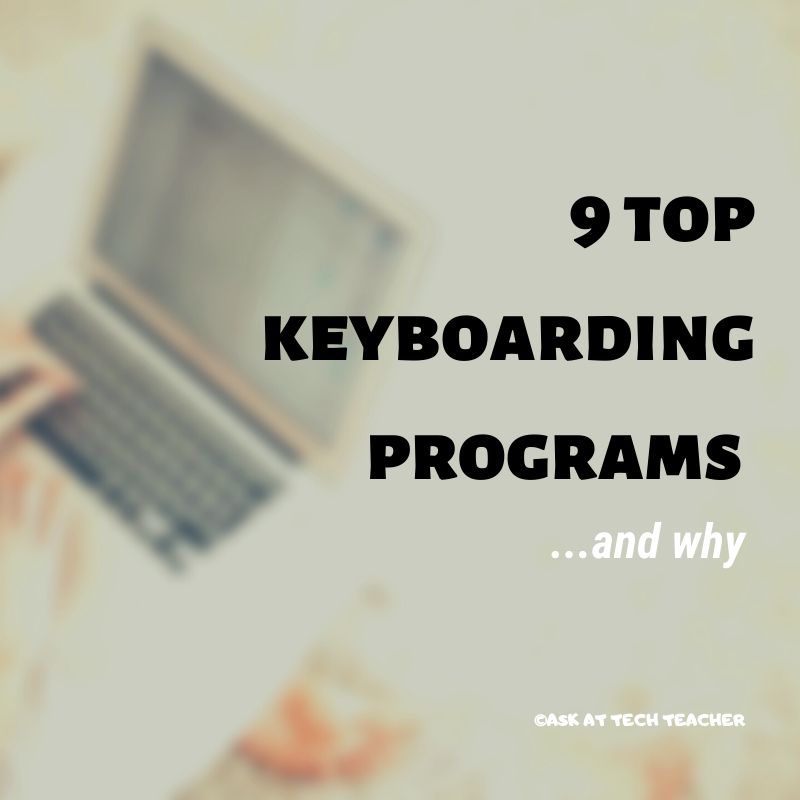 Keyboarding is a topic that most parents want their children to learn and many schools don’t have time to teach. Of all topics on Ask a Tech Teacher, keyboarding is the most visited. If you’re looking for a curriculum for your K-8 classes, here are two popular ones we offer:
Keyboarding is a topic that most parents want their children to learn and many schools don’t have time to teach. Of all topics on Ask a Tech Teacher, keyboarding is the most visited. If you’re looking for a curriculum for your K-8 classes, here are two popular ones we offer:
The Essential Guide–-a thorough K-8 curricula intended for schools that allot about 45 minutes a week to tech classes
The Ultimate Guide–a K-5 or MS comprehensive deep dive into keyboarding (optional student workbooks available)
We are taking the next two weeks–two articles–to answer the questions that should help you as a teacher or administrator decide what type of keyboarding program is best for your school.
Week 1 (this article)
- Why learn keyboarding?
- What is the best age to start teaching keyboarding?
- How important is teacher knowledge of teaching keyboarding?
Week 2 (click when available)
- What is the best way to teach keyboarding?
- What is the correct body position?
- What about keyboarding homework?
- Questions you may have
***
Here are the quick answers to the Week 1 questions:
- To develop good habits and facility as early as possible.
- As soon as students use a computer
- Critical
But don’t take my word for it. Here–briefly–is a summation of the research:
1 Why Learn Keyboarding
Student writing develops faster through word processing because it facilitates the review and revision learning process.
Zeitz, 2008
Many studies have documented the benefits of proper typing technique (McKay, 1998; Owston, 1997; Bartholome, 1996; Bieman, 1996; Hoot, 1986). Rogers (2003), including:
- Improvement in language arts
- Efficient usage of computers as writing, editing, and computing tools
- Better attitude toward writing—less frustration looking for keys; more satisfying entering information
- Confidence using computers which motivates students to do schoolwork
- Improved creative thought
- Prepare students for a technological society
Besides what research tells us, you see the benefits just by watching kids use computers. If you’ve ever seen a third grader struggle to type a web address into the computer or type a book report when they don’t know where the keys are, you know they should have started keyboarding earlier. And, the benefit to learning challenged students of proficiency on the keyboard can’t be overstated.
2 What is the best age to introduce keyboarding?
An overview of research says elementary and middle schoolage students are cognitively, emotionally, and physically capable of learning and excelling at keyboarding skills. Just as with piano and violin (and any number of sports), their fine motor skills, mental processes, and physiologic development are mature enough for the demands of typing.
But let’s dig deeper.
Some researchers maintain keyboarding is too abstract for immature brains and too demanding of undeveloped fine motor skills. Let’s look at that claim. To master keyboarding, one must be able to let fingers flow freely (Waner, Behymer, & McCrary, 1992), a concept backed by Bloom’s idea of automaticity and discussed by Wronkovich (1998), who defines it as a “system of automatic habits corresponding to the system of tasks”. I agree. The key is introduce age-appropriate skills. In a macro sense, correct keyboarding takes into account cognitive maturity, fine motor skills and age-appropriateness of skills taught. These three factors must constantly be considered and adapted in lessons.
If you don’t start children early enough, you get chaos:
Children often develop their own inefficient hunt-and-peck systems that take longer, waste limited computer time, and develop habits that are difficult to change.
–Type to Learn, 1986
Most researchers agree effective keyboarding isn’t instinctual and training should begin before bad habits are created. But when does that happen? Is elementary school too early—or too late? Research varies on this topic. Bartholome (1996) found that third grade is appropriate for touch keyboarding, but first and second graders can learn this skill as well if given adequate instruction. This conclusion was reinforced by Feutz (2001). On the opposite side is Erthal (2002) who found that third graders do not possess the manual dexterity required for keyboarding, and Hopkins (1998) who considered fourth grade an appropriate age for the commencement of formal keyboarding.
We are left with a mushy consensus among researchers that third-fifth grade is the appropriate time to begin keyboarding skills.
But today’s fifth grade may be too late. Young children are in front of keyboards earlier than ever. In the absence of training, they will learn, but likely wrong. Therefore, logic dictates we teach keyboarding:
- when teachers expect projects that require keyboarding
- when a child’s interests dictate a demand for typing
- when students are expected to use classroom computers
- by fourth grade: A trained fourth grader can write and type at the same speed
From my experience, that’s third grade with this caveat: Teach pre-keyboard skills kindergarten-second grade before beginning the focus on traditional skills of posture-speed-accuracy.
3 How important is teacher knowledge of teaching keyboarding?
Sormunen’s 1991 study found that classroom instructors were teaching keyboarding, but only 12% had any formal preparation in how to do that. Condon’s 1989 study found that educational administrators felt elementary teachers should be provided with sufficient training to teach keyboarding. McLean (1994) suggested that instruction can be supplied by teachers who have taken a keyboarding methods course. Consensus of most studies indicates a “knowledgeable” teacher is critical to help students develop appropriate techniques, as well as provide motivation and reinforcement (Nieman, 1996; Erthal, 1998).
Next week, we’ll talk about the mechanics of teaching keyboarding:
- What is the best way to teach keyboarding?
- What is the correct body position?
- What about keyboarding homework?
- Questions you may have
Jacqui Murray has been teaching K-18 technology for 30 years. She is the editor/author of over a hundred tech ed resources including a K-12 technology curriculum, K-8 keyboard curriculum, K-8 Digital Citizenship curriculum. She is an adjunct professor in tech ed, Master Teacher, webmaster for four blogs, an Amazon Vine Voice, freelance journalist on tech ed topics, and author of the tech thrillers, To Hunt a Sub and Twenty-four Days. You can find her resources at Structured Learning.





































I took typing in school (Yes, I’m that old.😊) The necessity of mastering the keyboard seems like a no-brainer in this day and age. One of our kindergarten teachers was our old tech guy, so he even pushed it for kids in kindergarten. Like everything else in child development, there isn’t a one size fits all.
My school actually entertained discussions about keyboarding being unnecessary until MS. It shocked me, but lots of schools–in a search for what they could cut out of the school day–hoped that was keyboarding. No. Look elsewhere.